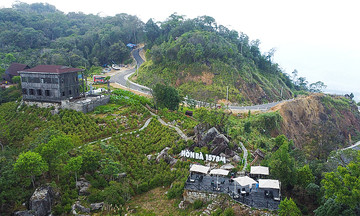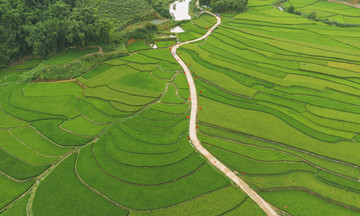According to 91-year-old Hue culinary artisan Mai Thi Tra, Hue beef noodle soup originated from traditional religious life. In ancient village ceremonies, the meat offered as a sacrifice was made into a stew eaten with sticky rice. When noodles became more common, people replaced the sticky rice with noodles for convenience and affordability. This new dish gradually evolved into the Hue beef noodle soup we know today. Over time, additions like pig's knuckles, crab cakes, blood cubes, and fresh herbs transformed the dish into a bowl combining both aroma and color.
 |
Hue beef noodle soup with crab cakes, rare beef, and pig's knuckles. Photo: JourneysinHue |
Hue beef noodle soup with crab cakes, rare beef, and pig's knuckles. Photo: JourneysinHue
Van Cu village, the cradle of traditional noodle-making for over 400 years, is another factor contributing to the dish's fame. The noodles here are white, chewy, and perfectly soft, absorbing the broth without falling apart – as if born solely for Hue beef noodle soup.
Artisan Tra recalls that in the past, women would carry shoulder poles laden with pots of beef noodle soup through the streets. Available at any time of day, it became an integral part of daily life and is considered the "soul" of Hue. Each cook has their own secret, ensuring no two bowls are ever the same, adding to the dish's cultural depth.
The soul of the dish lies in the broth. Beef bones are thoroughly washed, blanched, and then simmered uncovered over low heat. After repeated skimming, the broth becomes clear and naturally sweet. Lemongrass and shrimp paste are the dominant spices, creating the characteristic aroma of Hue beef noodle soup. The lemongrass is added whole, while the shrimp paste is dissolved in cold water and strained to create a rich flavor that doesn't overpower.
A traditional bowl includes a slice of pig's knuckle, thin slices of beef shank or brisket, a piece of blood cube, all immersed in the shimmering orange-red broth. The color comes from chili oil, combined with chopped scallions, creating a spicy and visually appealing dish.
According to Vietnamese culinary artisan Ho Dac Thieu Anh, "authentic" Hue beef noodle soup must be spicy – the heat coming from lemongrass, chili oil, chili sauce, and fresh chili slices steeped in the accompanying fish sauce. The sweetness should also be balanced, derived from the bones and ingredients rather than added sugar.
 |
Traditional pot for cooking Hue beef noodle soup. Photo: Ho Ngoc Doan Khuong |
Traditional pot for cooking Hue beef noodle soup. Photo: Ho Ngoc Doan Khuong
People in Hue also have a secret to preserving the flavor of the dish: the cooking pot. Described in Dr. Tran Duc Anh Son's book "Kieu Hue," it's an aluminum pot, shaped like a clay pot with a rounded bottom, a narrow neck, and a deep body but small opening, which effectively retains heat. Many gourmets believe that a bowl served from this traditional pot always tastes richer and more authentic.
Ms. Thieu Anh believes Hue beef noodle soup is not only delicious but also a nourishing dish according to Eastern culinary philosophy. Beef invigorates the blood, pig's knuckles detoxify and boost energy, and lemongrass aids digestion and relieves colds. The bowl of noodles represents a harmonious balance of yin and yang, both delicious and healthy.
People in Hue don't usually call the noodles they're eating "Hue beef noodle soup." To them, it's simply beef noodle soup – a familiar everyday dish. It's those who have left Hue, or visitors from other regions, who use the full name "Hue beef noodle soup" to emphasize the origin and distinctive cooking style of the ancient capital's cuisine, distinguishing it from variations in other regions.
From small roadside stalls, the dish has transcended local boundaries, spreading throughout Vietnam and reaching the world. Hue beef noodle soup now features on the menus of many restaurants in the USA, France, Canada, and Australia. Wherever it goes, the name "Hue" remains, a promise of authentic flavor and the cultural depth of the land that birthed this dish.
Tuan Anh












